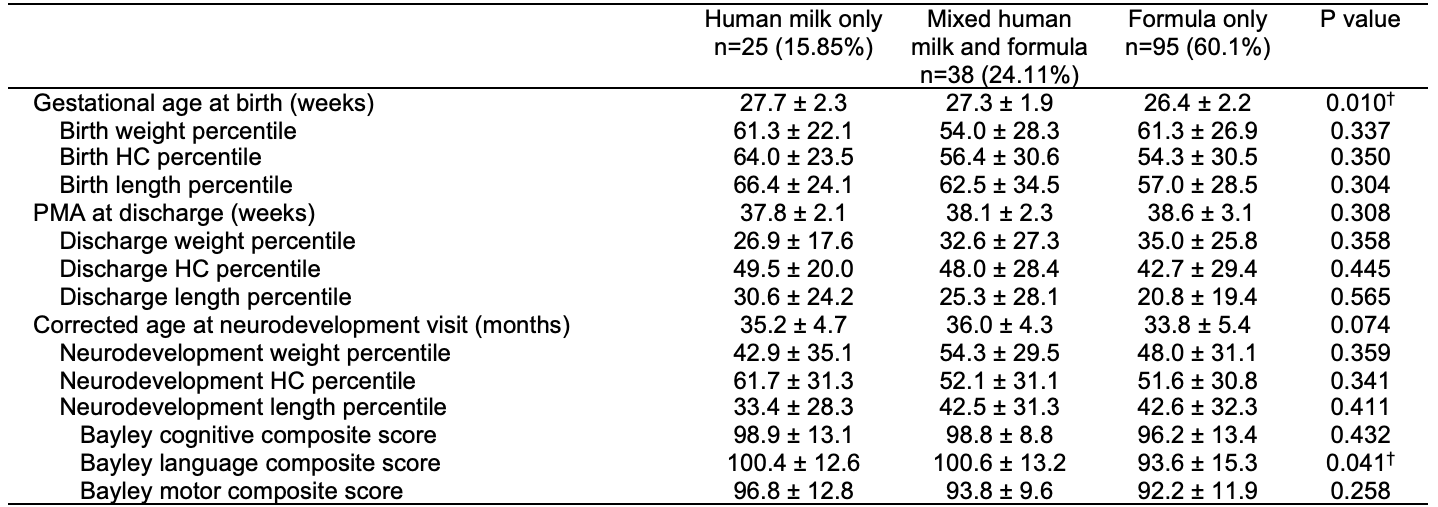Neonatal Follow-up
Category: Abstract Submission
Neonatal Follow-up II
249 - Exclusive Human Milk Diet at Neonatal Intensive Care Unit Discharge Supports Growth and Long-Term Development in Very Preterm Infants
Saturday, April 23, 2022
3:30 PM - 6:00 PM US MT
Poster Number: 249
Publication Number: 249.224
Publication Number: 249.224
Wenona Lok, Maria Fareri Children's Hospital at Westchester Medical Center, White Plains, NY, United States; Jordan S. Kase, Maria Fareri Children's Hospital at Westchester Medical Center, Valhalla, NY, United States

Wenona Lok, DO
Pediatric Resident
Maria Fareri Children's Hospital at Westchester Medical Center
White Plains, New York, United States
Presenting Author(s)
Background: An exclusive human milk diet (EHMD) has numerous known benefits for term and preterm infants. Formula supplementation may be recommended to former preterm infants after Neonatal Intensive Care Unit (NICU) discharge (DC) in an attempt to meet perceived metabolic demands and caloric goals. Recommendations addressing post DC nutrition for very preterm infants (VPTI) is controversial as the benefits of human milk supplementation regarding long term growth, neurodevelopment (ND), and chronic conditions are mixed.
Objective: To compare long term growth and ND of former VPTI fed an EHMD or a supplemented/formula diet at NICU DC.
Design/Methods: Retrospective cohort study of VPTI followed in the Regional Neonatal Follow Up Program who had their 1st outpatient follow up (FU) visit within 1 to 4 months of NICU DC. All subjects had weights documented at birth, NICU DC, and 1st FU. Anthropometrics (weight, head circumference (HC), and length) were plotted for percentiles using Fenton, WHO, and CDC growth charts for post menstrual age ≤50 weeks, corrected age (CA) 0-24 months, and CA >24 months respectively. HC percentiles for CA >36 months were obtained using WHO growth chart. Patients were categorized by diet at NICU DC: EHMD; mixed diet (EHMD and formula); formula only. Anthropometric percentiles were compared by diet at NICU DC at all above time points. ND outcomes as measured by the Bayley Scales of Infant Development 3rd Ed and anthropometrics at the time of ND testing were compared by diet at NICU DC. Continuous variables were compared using ANOVA and categorical variables using chi square. P value ≤0.05 is statistically significant.
Results: Among 835 VPTIs, all anthropometric percentiles at 1st FU visit (mean CA 1.5 months) were similar between the 3 NICU DC diet types (Table 1). This was achieved despite the fact that infants DC’d on a mixed diet had a larger HC at NICU DC. 158 subjects received ND evaluations (mean CA 34.6 months); anthropometric percentiles were similar irrespective of diet at NICU DC. Diet at NICU DC was not associated with any difference in cognitive or motor scores. However, infants DC’d on an EHMD or mixed diet had higher language scores than those DC’d on formula only (Table 2).Conclusion(s): Although an EHMD may not provide as many calories as an exclusive formula diet, it offers proteins which aid digestion and lipids essential for brain development. These benefits may result in maintained growth through 3 years of age observed in our study among VPTI fed an EHMD at NICU DC. Further, any diet at NICU DC containing human milk may augment language skills through 3 years of age.
Lok CVCV (last updated 01 2022).pdf
Growth and Neurodevelopment at 3 Year Follow Up by Diet at NICU Discharge † P value ≤ 0.05. HC: head circumference; PMA: post menstrual age; All continuous variables represented as mean ± standard deviation (SD)
† P value ≤ 0.05. HC: head circumference; PMA: post menstrual age; All continuous variables represented as mean ± standard deviation (SD)
Objective: To compare long term growth and ND of former VPTI fed an EHMD or a supplemented/formula diet at NICU DC.
Design/Methods: Retrospective cohort study of VPTI followed in the Regional Neonatal Follow Up Program who had their 1st outpatient follow up (FU) visit within 1 to 4 months of NICU DC. All subjects had weights documented at birth, NICU DC, and 1st FU. Anthropometrics (weight, head circumference (HC), and length) were plotted for percentiles using Fenton, WHO, and CDC growth charts for post menstrual age ≤50 weeks, corrected age (CA) 0-24 months, and CA >24 months respectively. HC percentiles for CA >36 months were obtained using WHO growth chart. Patients were categorized by diet at NICU DC: EHMD; mixed diet (EHMD and formula); formula only. Anthropometric percentiles were compared by diet at NICU DC at all above time points. ND outcomes as measured by the Bayley Scales of Infant Development 3rd Ed and anthropometrics at the time of ND testing were compared by diet at NICU DC. Continuous variables were compared using ANOVA and categorical variables using chi square. P value ≤0.05 is statistically significant.
Results: Among 835 VPTIs, all anthropometric percentiles at 1st FU visit (mean CA 1.5 months) were similar between the 3 NICU DC diet types (Table 1). This was achieved despite the fact that infants DC’d on a mixed diet had a larger HC at NICU DC. 158 subjects received ND evaluations (mean CA 34.6 months); anthropometric percentiles were similar irrespective of diet at NICU DC. Diet at NICU DC was not associated with any difference in cognitive or motor scores. However, infants DC’d on an EHMD or mixed diet had higher language scores than those DC’d on formula only (Table 2).Conclusion(s): Although an EHMD may not provide as many calories as an exclusive formula diet, it offers proteins which aid digestion and lipids essential for brain development. These benefits may result in maintained growth through 3 years of age observed in our study among VPTI fed an EHMD at NICU DC. Further, any diet at NICU DC containing human milk may augment language skills through 3 years of age.
Lok CVCV (last updated 01 2022).pdf
Growth and Neurodevelopment at 3 Year Follow Up by Diet at NICU Discharge
 † P value ≤ 0.05. HC: head circumference; PMA: post menstrual age; All continuous variables represented as mean ± standard deviation (SD)
† P value ≤ 0.05. HC: head circumference; PMA: post menstrual age; All continuous variables represented as mean ± standard deviation (SD)